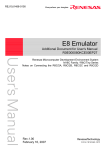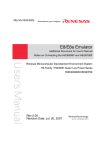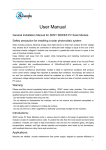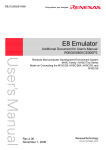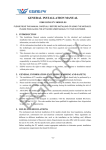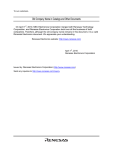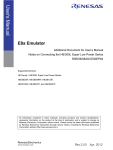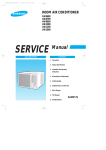Download E8a Emulator Additional Document for User`s Manual
Transcript
User’s Manual E8a Emulator Additional Document for User’s Manual Notes on Connecting the H8S/20103, H8S/20203, H8S/20223, H8S/20115, H8S/20215, H8S/20235, H8S/20103R, H8S/20203R, H8S/20223R, H8S/20323R, H8S/20115R, H8S/20215R, H8S/20235R, and H8S/20335R Group H8S/Tiny Series R0E00008AKCE00EP51 All information contained in these materials, including products and product specifications, represents information on the product at the time of publication and is subject to change by Renesas Electronics Corporation without notice. Please review the latest information published by Renesas Electronics Corporation through various means, including the Renesas Electronics Corporation website (http://www.renesas.com). www.renesas.com Rev.5.00 Feb. 2013 Notice 1. Descriptions of circuits, software and other related information in this document are provided only to illustrate the operation of semiconductor products and application examples. You are fully responsible for the incorporation of these circuits, software, and information in the design of your equipment. Renesas Electronics assumes no responsibility for any losses incurred by you or third parties arising from the use of these circuits, software, or information. 2. Renesas Electronics has used reasonable care in preparing the information included in this document, but Renesas Electronics does not warrant that such information is error free. Renesas Electronics assumes no liability whatsoever for any damages incurred by you resulting from errors in or omissions from the information included herein. 3. Renesas Electronics does not assume any liability for infringement of patents, copyrights, or other intellectual property rights of third parties by or arising from the use of Renesas Electronics products or technical information described in this document. No license, express, implied or otherwise, is granted hereby under any patents, copyrights or other intellectual property rights of Renesas Electronics or others. 4. You should not alter, modify, copy, or otherwise misappropriate any Renesas Electronics product, whether in whole or in part. Renesas Electronics assumes no responsibility for any losses incurred by you or third parties arising from such alteration, modification, copy or otherwise misappropriation of Renesas Electronics product. 5. Renesas Electronics products are classified according to the following two quality grades: “Standard” and “High Quality”. The recommended applications for each Renesas Electronics product depends on the product’s quality grade, as indicated below. “Standard”: Computers; office equipment; communications equipment; test and measurement equipment; audio and visual equipment; home electronic appliances; machine tools; personal electronic equipment; and industrial robots etc. “High Quality”: Transportation equipment (automobiles, trains, ships, etc.); traffic control systems; anti-disaster systems; anticrime systems; and safety equipment etc. Renesas Electronics products are neither intended nor authorized for use in products or systems that may pose a direct threat to human life or bodily injury (artificial life support devices or systems, surgical implantations etc.), or may cause serious property damages (nuclear reactor control systems, military equipment etc.). You must check the quality grade of each Renesas Electronics product before using it in a particular application. You may not use any Renesas Electronics product for any application for which it is not intended. Renesas Electronics shall not be in any way liable for any damages or losses incurred by you or third parties arising from the use of any Renesas Electronics product for which the product is not intended by Renesas Electronics. 6. You should use the Renesas Electronics products described in this document within the range specified by Renesas Electronics, especially with respect to the maximum rating, operating supply voltage range, movement power voltage range, heat radiation characteristics, installation and other product characteristics. Renesas Electronics shall have no liability for malfunctions or damages arising out of the use of Renesas Electronics products beyond such specified ranges. 7. Although Renesas Electronics endeavors to improve the quality and reliability of its products, semiconductor products have specific characteristics such as the occurrence of failure at a certain rate and malfunctions under certain use conditions. Further, Renesas Electronics products are not subject to radiation resistance design. Please be sure to implement safety measures to guard them against the possibility of physical injury, and injury or damage caused by fire in the event of the failure of a Renesas Electronics product, such as safety design for hardware and software including but not limited to redundancy, fire control and malfunction prevention, appropriate treatment for aging degradation or any other appropriate measures. Because the evaluation of microcomputer software alone is very difficult, please evaluate the safety of the final products or systems manufactured by you. 8. Please contact a Renesas Electronics sales office for details as to environmental matters such as the environmental compatibility of each Renesas Electronics product. Please use Renesas Electronics products in compliance with all applicable laws and regulations that regulate the inclusion or use of controlled substances, including without limitation, the EU RoHS Directive. Renesas Electronics assumes no liability for damages or losses occurring as a result of your noncompliance with applicable laws and regulations. 9. Renesas Electronics products and technology may not be used for or incorporated into any products or systems whose manufacture, use, or sale is prohibited under any applicable domestic or foreign laws or regulations. You should not use Renesas Electronics products or technology described in this document for any purpose relating to military applications or use by the military, including but not limited to the development of weapons of mass destruction. When exporting the Renesas Electronics products or technology described in this document, you should comply with the applicable export control laws and regulations and follow the procedures required by such laws and regulations. 10. It is the responsibility of the buyer or distributor of Renesas Electronics products, who distributes, disposes of, or otherwise places the product with a third party, to notify such third party in advance of the contents and conditions set forth in this document, Renesas Electronics assumes no responsibility for any losses incurred by you or third parties as a result of unauthorized use of Renesas Electronics products. 11. This document may not be reproduced or duplicated in any form, in whole or in part, without prior written consent of Renesas Electronics. 12. Please contact a Renesas Electronics sales office if you have any questions regarding the information contained in this document or Renesas Electronics products, or if you have any other inquiries. (Note 1) “Renesas Electronics” as used in this document means Renesas Electronics Corporation and also includes its majorityowned subsidiaries. (Note 2) “Renesas Electronics product(s)” means any product developed or manufactured by or for Renesas Electronics. (2012.4) Regulatory Compliance Notices European Union regulatory notices This product complies with the following EU Directives. (These directives are only valid in the European Union.) CE Certifications: • Electromagnetic Compatibility (EMC) Directive 2004/108/EC EN 55022 Class A WARNING: This is a Class A product. In a domestic environment this product may cause radio interference in which case the user may be required to take adequate measures. EN 55024 • Information for traceability • Authorised representative Name: Renesas Electronics Corporation Address: 1753, Shimonumabe, Nakahara-ku, Kawasaki, Kanagawa, 211-8668, Japan • Manufacturer Name: Renesas Solutions Corp. Address: Nippon Bldg., 2-6-2, Ote-machi, Chiyoda-ku, Tokyo 100-0004, Japan • Person responsible for placing on the market Name: Renesas Electronics Europe Limited Address: Dukes Meadow, Millboard Road, Bourne End, Buckinghamshire, SL8 5FH, U.K. Environmental Compliance and Certifications: • Waste Electrical and Electronic Equipment (WEEE) Directive 2002/96/EC WEEE Marking Notice (European Union Only) Renesas development tools and products are directly covered by the European Union's Waste Electrical and Electronic Equipment, (WEEE), Directive 2002/96/EC. As a result, this equipment, including all accessories, must not be disposed of as household waste but through your locally recognized recycling or disposal schemes. As part of our commitment to environmental responsibility Renesas also offers to take back the equipment and has implemented a Tools Product Recycling Program for customers in Europe. This allows you to return equipment to Renesas for disposal through our approved Producer Compliance Scheme. To register for the program, click here “http://www.renesas.com/weee". United States Regulatory notices on Electromagnetic compatibility FCC Certifications (United States Only): This equipment has been tested and found to comply with the limits for a Class A digital device, pursuant to Part 15 of the FCC Rules. These limits are designed to provide reasonable protection against harmful interference when the equipment is operated in a commercial environment. This equipment generates, uses, and can radiate radio frequency energy and, if not installed and used in accordance with the instruction manual, may cause harmful interference to radio communications. Operation of this equipment in a residential area is likely to cause harmful interference in which case the user will be required to correct the interference at his own expense. CAUTION: Changes or modifications not expressly approved by the party responsible for compliance could void the user's authority to operate the equipment. Table of Contents Section 1 Inside the E8a Emulator User’s Manual ................................................................................ 1 Section 2 Connecting the Emulator with the User System .................................................................... 3 Section 3 Pin Assignments of the E8a Connector .................................................................................5 Section 4 Example of Emulator Connection.......................................................................................... 7 Section 5 Software Specifications when Using the Emulator ............................................................. 13 5.1 Differences between the MCU (H8S/20103, H8S/20203, H8S/20223, H8S/20115, H8S/20215, H8S/20235, H8S/20103R, H8S/20203R, H8S/20223R, H8S/20323R, H8S/20115R, H8S/20215R, H8S/20235R, and H8S/20335R Group) and the Emulator ................................................................................................................... 13 Note: This manual applies to the following product versions of the E8a emulator software. Table E8a Emulator Software E8a Emulator V.1.05 Release 00 or later (H8 Tiny/Super Low Power E8a Emulator V.1.03.00 or later)* Note: This is a revision of the debugger. E8a Emulator Section 1 Inside the E8a Emulator User’s Manual Section 1 Inside the E8a Emulator User’s Manual The E8a emulator manual consists of two documents: the E8a User’s Manual and the E8a Additional Document for User’s Manual (this document). Be sure to read BOTH documents before using the E8a emulator. (1) E8a Emulator User’s Manual The E8a Emulator User’s Manual describes the hardware specifications and how to use the emulator debugger. ⎯ E8a emulator hardware specifications ⎯ Connecting the E8a emulator to the host computer or user system ⎯ Operating the E8a emulator debugger ⎯ Tutorial: From starting up the E8a emulator debugger to debugging (2) E8a Additional Document for User’s Manual The E8a Additional Document for User’s Manual describes content dependent on the MCUs and precautionary notes. ⎯ Example of the E8a emulator connection or interface circuit necessary for designing the hardware ⎯ Notes on using the E8a emulator ⎯ Setting the E8a emulator debugger during startup R20UT0999EJ0500 Rev. 5.00 Feb 14, 2013 Page 1 of 26 E8a Emulator R20UT0999EJ0500 Rev. 5.00 Feb 14, 2013 Section 1 Inside the E8a Emulator User’s Manual Page 2 of 26 E8a Emulator Section 2 Connecting the Emulator with the User System Section 2 Connecting the Emulator with the User System Before connecting an E8a emulator (hereafter referred to as emulator) with the user system, a connector must be installed in the user system so that a user system interface cable can be connected. When designing the user system, refer to the connector and recommended circuits shown in this manual. Before designing the user system, be sure to read the E8a emulator user’s manual and the hardware manual for related MCUs. The E8a emulator supports the flash MCUs of H8S/20103, H8S/20203, H8S/20223, H8S/20115, H8S/20215, H8S/20235, H8S/20103R, H8S/20203R, H8S/20223R, H8S/20323R, H8S/20115R, H8S/20215R, H8S/20235R, and H8S/20335R group (hereafter referred to as the MCU unless the description is specific to any of them). Table 2.1 shows the recommended connector for the emulator. Table 2.1 Recommended Connector Type Number Manufacturer Specifications 7614-6002OO∗ 3M Limited 14-pin straight type R20UT0999EJ0500 Rev. 5.00 Feb 14, 2013 Page 3 of 26 E8a Emulator Section 2 Connecting the Emulator with the User System Connect pins 2, 4, 6, 10, 12, and 14 of the user system connector to GND firmly on the PCB. These pins are used as electrical GND and to monitor the connection of the user system connector. Note the pin assignments of the user system connector. User system interface cable User system connector User system Pin 2 Pin 1 Figure 2.1 Connecting the User System Interface Cable to the User System Notes: 1. The pin number assignments of the 14-pin connector differ from those of the E10AUSB emulator; however, the physical location is the same. 2. Do not place any components within 3 mm of the connector. 3. When the emulator is used in the [Program Flash] mode, connect the emulator similarly to the user system. R20UT0999EJ0500 Rev. 5.00 Feb 14, 2013 Page 4 of 26 E8a Emulator Section 3 Pin Assignments of the E8a Connector Section 3 Pin Assignments of the E8a Connector Figure 3.1 shows the pin assignments of the emulator′s connector. Pin 1 mark Connector Pin 14 Pin 13 Pin 2 Pin 1 Top view Pin 1 mark Pin No. MCU Signal 1 P87 2 Vss 3 N.C. *2 4 Vss 5 P86 6 Vss 7 NMI# *1 8 Vcc 9 N.C. *2 10 Vss 11 P85 12 Vss 13 RES# *1 14 Vss Notes: 1. The symbol (#) means that the signal is active-low. 2. These pins are not used in the H8S/Tiny series. Do not connect anything to these pins. Figure 3.1 Pin Assignments of the Emulator′s Connector R20UT0999EJ0500 Rev. 5.00 Feb 14, 2013 Page 5 of 26 E8a Emulator R20UT0999EJ0500 Rev. 5.00 Feb 14, 2013 Section 3 Pin Assignments of the E8a Connector Page 6 of 26 E8a Emulator Section 4 Example of Emulator Connection Section 4 Example of Emulator Connection Figure 4.1 shows an example of emulator connection to the MCU. Control pins which do not appear in this figure, such as TEST, OSC1, and OSC2, affect the operation of the emulator. For handling of those pins, refer to the H8S/20103, H8S/20203, H8S/20223, H8S/20115, H8S/20215, and H8S/20235 group hardware manual and H8S/20103R, H8S/20203R, H8S/20223R, H8S/20323R, H8S/20115R, H8S/20215R, H8S/20235R, and H8S/20335R group hardware manual. Pulled-up at 4.7 kΩ or more Vcc Vcc Vcc Vcc Vcc Vcc NMI# NMI# P85 P85 P86 P86 P87 P87 Vcc User logic MCU * RES# RES# Pulled-up at 4.7 kΩ or more Vss User system *: Open-collector buffer Connector 14 pins with a 2.54-mm pitch Figure 4.1 Example of Emulator Connection R20UT0999EJ0500 Rev. 5.00 Feb 14, 2013 Page 7 of 26 E8a Emulator Section 4 Example of Emulator Connection Notes: 1. P85 to P87 pins are used by the emulator. Pull up and connect the emulator and MCU pins. MCU User system connector Vcc 4.7 kΩ Pins 1, 5, and 11 P85 to P87 pin Figure 4.2 Connection of Emulator and P85 to P87 Pins 2. The NMI# signal is used for forced break control by the emulator. Connect the emulator and MCU pins directly. MCU User system connector Vcc 4.7 kΩ NMI# pin Pin 7 Figure 4.3 Connection of Emulator and NMI# Pin R20UT0999EJ0500 Rev. 5.00 Feb 14, 2013 Page 8 of 26 E8a Emulator 3. Section 4 Example of Emulator Connection The RES# pin is used by the emulator. If the user system has a reset control circuit (hereafter referred to as user logic), connect pin 13 of the user system connector and the output signal of the user logic via the open-collector buffer as shown below. If there is no user logic, connect pin 13 directly to the RES# pin of the MCU. When with the user logic: Vcc User system connector User logic MCU 4.7 kΩ * RES# pin Pin 13 *Open-collector output buffer When without the user logic: User system connector MCU Vcc 4.7 kΩ RES# pin Pin 13 Figure 4.4 Example of a Reset Circuit 4. Connect Vss and Vcc with the Vss and Vcc of the MCU, respectively. 5. Connect nothing with N.C. 6. The amount of voltage permitted to input to Vcc must be within the guaranteed range of the MCU. R20UT0999EJ0500 Rev. 5.00 Feb 14, 2013 Page 9 of 26 E8a Emulator Section 4 Example of Emulator Connection 7. When the MCU in use is connected to the emulator, the pin functions listed below are not available. Table 4.1 Pin Functions Not Available H8S/20103, H8S/20203, H8S/20223, H8S/20115, H8S/20215, H8S/20235, H8S/20103R, H8S/20203R, H8S/20223R, H8S/20323R, H8S/20115R, H8S/20215R, H8S/20235R, and H8S/20335R group P85-P87 NMI# TREO, TRBO, and TRAIO WARNING In the power-supply mode, connect the emulator after checking that the power-supply circuit on the user system is not closed or the pin number assignments of the user system connector is correct. Failure to do so will result in a FIRE HAZARD and will damage the host computer, the emulator, and the user system. R20UT0999EJ0500 Rev. 5.00 Feb 14, 2013 Page 10 of 26 E8a Emulator 8. Section 4 Example of Emulator Connection Figure 4.5 shows the interface circuit in the E8a emulator. Use this figure as a reference when determining the pull-up resistance value. User system connector Power-supply circuit (only used for the power-supply mode) Vcc 100 kΩ x3 Emulator control circuit 1 MΩ 8 100 kΩ 22 Ω P87 1 74LVC125B 22 Ω P85 11 74LVC125B 22 Ω NMI# 7 74LVC125B Vcc 3.3 V SN74LVC2T45 3.3 V Vcc 22 Ω P86 SN74LVC2T45 3.3 V Vcc 22 Ω SN74LVC2T45 3.3 V 10 kΩ RES# 5 13 2CS2462 10 kΩ Notes: 1. This figure omits the test circuits and pin numbers 2, 3, 4, 6, 9, 10, 12, and 14 for the user connector that are not used when H8S/Tiny series is connected. 2. The power of 74LVC125B is supplied from Vcc in the user connector (or in the power-supply circuit during power-supply mode). Figure 4.5 Interface Circuit in the E8a Emulator (Reference) R20UT0999EJ0500 Rev. 5.00 Feb 14, 2013 Page 11 of 26 E8a Emulator R20UT0999EJ0500 Rev. 5.00 Feb 14, 2013 Section 4 Example of Emulator Connection Page 12 of 26 E8a Emulator Section 5 Software Specifications when Using the Emulator Section 5 Software Specifications when Using the Emulator 5.1 Differences between the MCU (H8S/20103, H8S/20203, H8S/20223, H8S/20115, H8S/20215, H8S/20235, H8S/20103R, H8S/20203R, H8S/20223R, H8S/20323R, H8S/20115R, H8S/20215R, H8S/20235R, and H8S/20335R Group) and the Emulator This section describes the differences between the emulator and MCU operations. 1. [Emulator Setting] Dialog Box The [Emulator Setting] dialog box is provided for setting the items that need to be set when the emulator starts up (settings are saved in the session). Figure 5.1 [Emulator Setting] Dialog Box R20UT0999EJ0500 Rev. 5.00 Feb 14, 2013 Page 13 of 26 E8a Emulator Section 5 Software Specifications when Using the Emulator To keep the [Emulator Setting] dialog box closed next time the emulator is started, check "Do not show this dialog box again." at the bottom of the [Emulator Setting] dialog box. You can open the [Emulator Setting] dialog box using either one of the following methods: ⎯ After the emulator gets started, select Menu - [Setup] -> [Emulator] -> [Emulator Setting...]. ⎯ Start the emulator while holding down the Ctrl key. ⎯ After the emulator gets started and an error occurred, restart the emulator. When you check "Do not show this dialog box again.", the emulator doesn't supply power to the user system. To use this check box, start the emulator after turning on the power. 2. Emulator Mode The selection of the device group, device, the specification of the mode, and the setting of the power supply are done in the [Emulator mode] page of the [Emulator Setting] dialog box. ⎯ Device Group Select the device group in use from the [Device Group] combo box. ⎯ Device Select the device name in use from the [Device] combo box. The following items are selected in the [Mode] group box. ⎯ Modes • Erase Flash and Connect This mode is used when there is no emulator program in the flash memory of the target device. In this mode, data of the flash memory of the target device is erased when the emulator is activated. Select this item when the emulator is firstly activated, the version of the emulator’s software is updated, or the ID code is changed. • Keep Flash and Connect This mode is used when there is an emulator program in the flash memory of the target device. Enter the ID code specified above (‘Erase Flash and Connect’). If an incorrect code is entered, all the programs on the flash memory will be erased. Note: When the emulator gets started in this mode after selecting "Do not show this dialog box again.", the initial values of the ID code are ‘0E8a’ for the E8a emulator. If you use the ID code other than the initial value, do not use "Do not show this dialog box again." R20UT0999EJ0500 Rev. 5.00 Feb 14, 2013 Page 14 of 26 E8a Emulator Section 5 Software Specifications when Using the Emulator • Program Flash This mode is used when the emulator is used for programming the flash memory. Debugging the program is disabled. To download the load module, register it in the workspace. Note: In the H8S/Tiny series, the ID code is not entered in the Program Flash mode. ⎯ Power Supply When [Power Target from emulator. (MAX 300mA)] is checked, power will be supplied to the user system up to 300 mA. 3. Emulator Activation and ID Code In the H8S/Tiny series, the [ID Code] dialog box is set when the emulator is activated. ⎯ Setting the ID code When the emulator is activated in the [Erase Flash and Connect] mode, enter any hexadecimal four-digit ID code to be set (except for H'FFFF). The initial value is H'0E8A. When the emulator is activated in the [Keep Flash and Connect] mode, enter the correct ID code. If an incorrect ID code is entered, all the contents of the flash memory will be erased. In this case, restart the emulator in the [Erase Flash and Connect] mode. Figure 5.2 [ID Code] Dialog Box R20UT0999EJ0500 Rev. 5.00 Feb 14, 2013 Page 15 of 26 E8a Emulator Section 5 Software Specifications when Using the Emulator 4. When the emulator system is initiated, it initializes the general registers and part of the control registers as shown in table 5.1. Table 5.1 Register Initial Values at Emulator Power-On Register Initial Value PC Reset vector value in the vector address table ER0 to ER6 H’0 ER7 (SP) H'10 CCR 1 for I mask, and others undefined EXR H’7F 5. Operating Clock during Breaks To speed up operations during breaks in execution of the user program, the CPU is made to use the high-speed clock for debugging as its operating clock. 6. RES# Signal The RES# signal is masked during breaks in execution of the user program. The RES# signal is accepted during user program execution when execution was started by clicking on the Go button or a step-type button. Note: Do not start user program execution or access the memory while control input signal (RES#) is being low. A TIMEOUT error will occur. 7. System Control Register In the emulator, the internal I/O registers can be accessed from the [IO] window. However, be careful when accessing the system control register. The emulator saves the register value of the system control register at a break and returns the value when the user program is executed. Since this is done during a break, do not rewrite the system control register in the [IO] window. 8. Memory Access during Emulation If the memory contents are referenced or modified during emulation, realtime emulation cannot be performed because the user program is temporarily halted. 9. The emulator communicates with the MCUs by using the NMI#, RES#, and P85 to P87 pins. R20UT0999EJ0500 Rev. 5.00 Feb 14, 2013 Page 16 of 26 E8a Emulator Section 5 Software Specifications when Using the Emulator 10. Sum Data Displayed in the Program Flash Mode Sum data, which is displayed in the ‘Program Flash’ mode, is a value that data in the whole ROM areas has been added by byte. 11. Note on Executing the User Program The set value is rewritten since the emulator uses flash memory register during programming (Go, Step In, Step Out, or Step Over) of the flash memory. 12. The power consumed by the MCU can reach several milliamperes. This is because the user power supply drives ICs to make the communication signal level match the user-system power-supply voltage. The emulator does not communicate during execution of the user program, so connecting the emulator only causes a small rise in power consumption. However, it rises more significantly during breaks in user-program execution. 13. Program Area for the Emulator The emulator program uses the IO, flash memory, and internal RAM ranges indicated in Table 5.2, so make sure access to locations in these ranges does not proceed. If the contents of the program area for the emulator are changed, the emulator will not operate normally. In this case, restart the emulator in the Erase Flash and Connect mode. Table 5.2 Program Area for the E8a Emulator MCU Name Program Area H8S/20103F, H8S/20102F, H8S/20203F, H8S/20202F, H8S/20223F, H8S/20222F, H8S/20115F, H8S/20114F, H8S/20215F, H8S/20214F, H8S/20235F, H8S/20234F, H8S/20103RF, H8S/20102RF, H8S/20203RF, H8S/20202RF, H8S/20223RF, H8S/20222RF, H8S/20323RF, H8S/20322RF, H8S/20115RF, H8S/20114RF, H8S/20215RF, H8S/20214RF, H8S/20235RF, H8S/20234RF, H8S/20335RF, H8S/20334RF Vector, etc.: H'00008 to H'0000F, H'00001C to H'00001F, H'000030 to H'00003F R20UT0999EJ0500 Rev. 5.00 Feb 14, 2013 IO, etc.: H'FF0514 to H'FF0517, H'FF05A0 to H'FF05AF, H'FF05D8 to H'FF05DD, H'FF06FC to H'FF071F, H'FF072E to H'FF073F, H'FF074E to H'FF075F Page 17 of 26 E8a Emulator Section 5 Software Specifications when Using the Emulator 14. Programming Flash Memory during Debugging The following functions use breakpoints and so lead to programming of the flash memory: • Executing [Go to cursor] • Stepping over a subroutine • Using step-out operation to execute a subroutine 15. Do not use an MCU that has been used for debugging. If the flash memory is rewritten many times, data may be lost due to retention problems after the emulator has been left for a few days and the data will be erased. If an error message is displayed, exchange the MCU for a new one. 16. Forced Break Function The vector address of NMI# is rewritten by the emulator program. An error will occur if a file in the host computer and the flash memory contents are verified. 17. Processing When Booting up the Emulator When the emulator is booted up, the watchdog timer (WDT) is not active, so the operation of the emulator differs in this way from that of an MCU when the emulator is not in use. When the MCU is initialized by a reset or in some other way after the emulator is booted up, the WDT becomes active. If you intend to use the WDT, set the WDT up as required from the initializing routine, while if you do not intend to use the WDT, stop activation of the WDT from the initializing routine. In products of the H8S/Tiny Series, the WDT runs at 125 kHz in its initial state, and a WDT reset occurs by an overflow. Consequently, note that a WDT reset will be generated unless an initializing routine is run right after the MCU is released from the reset state. 18. Updating the I/O Register Window and Memory Window during Debugging Registers such as the SSRDR of the Synchronous Serial Communications Unit (SSU), the ICDRR of the IIC Bus Interface Controller 2 (IIC2), and the RDR of Serial Communications Interface 3 (SCI3) are affected by the generation of read cycles. Displaying the contents of such peripheral function registers in the I/O register window or the memory window can lead to malfunctions of the peripheral function. R20UT0999EJ0500 Rev. 5.00 Feb 14, 2013 Page 18 of 26 E8a Emulator Section 5 Software Specifications when Using the Emulator 19. Items Set in the [Configuration] Dialog Box The emulator operation conditions are set in the [Configuration] dialog box. Figure 5.3 [Configuration] Dialog Box ([Emulator System] Page) Note: Online help has a description of [NMI signal group box] in [Windows] -> [Configuration] -> [Configuration dialog box – Emulator System page], but it is not supported by the H8S/Tiny series. R20UT0999EJ0500 Rev. 5.00 Feb 14, 2013 Page 19 of 26 E8a Emulator Section 5 Software Specifications when Using the Emulator Items that can be displayed in this dialog box are listed below. [Device] edit box Displays the MCU name. [User interface clock] edit box Displays the transfer clock of the user interface. [Emulation mode] combo box Selects the emulation mode at user program execution. Select Normal to perform normal emulation. Select No break to disable PC breakpoint or break condition settings during emulation. [Step option] combo box Sets the step interrupt option. Disable interrupts during single step execution: Disables interrupts during step execution. Enable interrupts during single step execution: Enables interrupts during step execution. [Step Over option] combo box *1 *1 Enables or disables programming of the flash memory while executing step operation. Programming of the flash memory: Uses a software break for step operation (e.g. Step Over) and enables programming of the flash memory. No Programming of the flash memory: Uses Break Condition for step operation (e.g. Step Over) and *2 disables programming of the flash memory . R20UT0999EJ0500 Rev. 5.00 Feb 14, 2013 Page 20 of 26 E8a Emulator [Flash memory synchronization] combo box Section 5 Software Specifications when Using the Emulator Selects whether or not the contents of the flash memory are acquired by the emulator when the user program is stopped or the position where the PC break is set is put back as the original code. When the flash memory is not programmed by the user program, its contents need not be acquired by the emulator. If there is no problem with the state that the program in the flash memory has been replaced as the PC break code, the position where the PC break is set needs not be put back as the original code. Disable: Read or program is not performed for the flash memory except when the emulator is activated, the flash memory area is modified, and the settings of the PC break to the flash memory area are changed. PC to flash memory: When the user program is stopped, the specified PC break code is replaced as the original instruction. Select this option if there is a problem with the state that the program in the flash memory has been replaced as the PC break code. Flash memory to PC: When the user program is stopped, the contents of the flash memory are read by the emulator. Select this option if the flash memory is reprogrammed by the user program. PC to flash memory, Flash memory to PC: When the user program is stopped, the contents of the flash memory are read by the emulator and the specified PC break code is replaced as the original instruction. Select this option if the flash memory is reprogrammed by the user program and there is a problem with the state that the program in the flash memory has been replaced as the PC break code. R20UT0999EJ0500 Rev. 5.00 Feb 14, 2013 Page 21 of 26 E8a Emulator [Flash memory write after download] group box Section 5 Software Specifications when Using the Emulator Enables or disables programming of the flash memory after downloading the program. Disable: Disables programming of the flash memory after downloading the program. Enable: Enables programming of the flash memory after downloading the program. [Short break] group box Enables or disables memory access during user program execution. Disable: Disables memory access during user program execution. Enable: Enables memory access during user program execution. [Trace mode] combo box [8 branch source] Displays the branch-source address or the mnemonic, operand, and source line. [4 branch source and 4 branch destination] Displays the branch-source and destination address or the mnemonic, operand, and source line. Notes: 1. Includes interrupts in a break. 2. When Step Over is performed after selecting [No Programming of the flash memory] for [Step Over option], the instruction that follows a JSR, BSR, or TRAPA instruction will also be executed. If there are consecutive JSR, BSR, or TRAPA instructions, execution proceeds until it reaches an instruction that is not JSR, BSR, or TRAPA. (When there are consecutive function calls in C language, the program steps all of these functions.) R20UT0999EJ0500 Rev. 5.00 Feb 14, 2013 Page 22 of 26 E8a Emulator Section 5 Software Specifications when Using the Emulator 20. [Break condition] Functions In the H8S/Tiny series E8a emulator, conditions of Break Condition 1,2,3,4,5,6,7,8,9,10 can be set. Table 5.3 lists the items that can be specified. Table 5.3 Hardware Break Condition Specification Items Items Description Address bus condition Breaks when the MCU address bus value matches the * specified value . Data bus condition Breaks when the MCU data bus value matches the specified value. High or low byte or word can be specified as the access data size. Read or write condition Breaks in the read or write cycle. Note: Break Condition 1 and 2 can decide mask setting for the address from lower 4 bits to 12 bits. Table 5.4 lists the combinations of conditions that can be set in the [Break condition] dialog box. Table 5.4 Conditions Set in [Break condition] Dialog Box Condition Dialog Box Address Bus Condition Data Condition Read or Write Condition [Break condition 1] O O O [Break condition 2] O O O [Break condition 3] O X X [Break condition 4] O X X [Break condition 5] O X X [Break condition 6] O X X [Break condition 7] O X X [Break condition 8] O X X [Break condition 9] O X X [Break condition 10] O X X Note: O: Can be set by checking the radio button in the dialog box. R20UT0999EJ0500 Rev. 5.00 Feb 14, 2013 Page 23 of 26 E8a Emulator Section 5 Software Specifications when Using the Emulator Table 5.5 lists the combinations of conditions that can be set by the BREAKCONDITION_ SET command. Table 5.5 Conditions Set by BREAKCONDITION_SET Command Condition Channel Address Bus Condition (<addropt> option) Data Condition (<dataopt> option) Read or Write Condition (<r/wopt> option) Break condition 1 O O O Break condition 2 O O O Break condition 3 O X X Break condition 4 O X X Break condition 5 O X X Break condition 6 O X X Break condition 7 O X X Break condition 8 O X X Break condition 9 O X X Break condition 10 O X X Note: O: Can be set by the BREAKCONDITION_SET command. • Notes on Setting the Break Condition 1. When [Step In], [Step Over], or [Step Out] is selected, the settings of Break Condition are disabled. 2. The settings of Break Condition are disabled when an instruction to which a BREAKPOINT has been set is executed. 3. When step over function is used, the settings of BREAKPOINT and Break Condition are disabled. (21) Description on Online Help • About Command line List and NMI_MODE of each command line interface Do not select the User type when the H8S/Tiny device is in use. When the user program is executed while the User type has been set, there is a possibility that the E8a emulator becomes uncontrollable. R20UT0999EJ0500 Rev. 5.00 Feb 14, 2013 Page 24 of 26 E8a Emulator Section 5 Software Specifications when Using the Emulator • About note Even though there is a description that “When the NMI signal is used, set NMI to be used in the user program in the [NMI signal] group box of the [Configuration] dialog box or with the NMI_MODE command.”, do not set the NMI_MODE command. R20UT0999EJ0500 Rev. 5.00 Feb 14, 2013 Page 25 of 26 E8a Emulator R20UT0999EJ0500 Rev. 5.00 Feb 14, 2013 Section 5 Software Specifications when Using the Emulator Page 26 of 26 E8a Emulator Additional Document for User’s Manual Notes on connecting the H8S/20103, H8S/20203, 8S/20223, H8S/20115, H8S/20215, H8S/20235, H8S/20103R, H8S/20203R, H8S/20223R, H8S/20323R, H8S/20115R, H8S/20215R, H8S/20235R, and H8S/20335R Group Publication Date: Published by: Rev.1.00, January 15, 2009 Rev.5.00, February 14, 2013 Renesas Electronics Corporation http://www.renesas.com SALES OFFICES Refer to "http://www.renesas.com/" for the latest and detailed information. Renesas Electronics America Inc. 2880 Scott Boulevard Santa Clara, CA 95050-2554, U.S.A. Tel: +1-408-588-6000, Fax: +1-408-588-6130 Renesas Electronics Canada Limited 1101 Nicholson Road, Newmarket, Ontario L3Y 9C3, Canada Tel: +1-905-898-5441, Fax: +1-905-898-3220 Renesas Electronics Europe Limited Dukes Meadow, Millboard Road, Bourne End, Buckinghamshire, SL8 5FH, U.K Tel: +44-1628-651-700, Fax: +44-1628-651-804 Renesas Electronics Europe GmbH Arcadiastrasse 10, 40472 Düsseldorf, Germany Tel: +49-211-65030, Fax: +49-211-6503-1327 Renesas Electronics (China) Co., Ltd. 7th Floor, Quantum Plaza, No.27 ZhiChunLu Haidian District, Beijing 100083, P.R.China Tel: +86-10-8235-1155, Fax: +86-10-8235-7679 Renesas Electronics (Shanghai) Co., Ltd. Unit 204, 205, AZIA Center, No.1233 Lujiazui Ring Rd., Pudong District, Shanghai 200120, China Tel: +86-21-5877-1818, Fax: +86-21-6887-7858 / -7898 Renesas Electronics Hong Kong Limited Unit 1601-1613, 16/F., Tower 2, Grand Century Place, 193 Prince Edward Road West, Mongkok, Kowloon, Hong Kong Tel: +852-2886-9318, Fax: +852 2886-9022/9044 Renesas Electronics Taiwan Co., Ltd. 13F, No. 363, Fu Shing North Road, Taipei, Taiwan Tel: +886-2-8175-9600, Fax: +886 2-8175-9670 Renesas Electronics Singapore Pte. Ltd. 80 Bendemeer Road, Unit #06-02 Hyflux Innovation Centre Singapore 339949 Tel: +65-6213-0200, Fax: +65-6213-0300 Renesas Electronics Malaysia Sdn.Bhd. Unit 906, Block B, Menara Amcorp, Amcorp Trade Centre, No. 18, Jln Persiaran Barat, 46050 Petaling Jaya, Selangor Darul Ehsan, Malaysia Tel: +60-3-7955-9390, Fax: +60-3-7955-9510 Renesas Electronics Korea Co., Ltd. 11F., Samik Lavied' or Bldg., 720-2 Yeoksam-Dong, Kangnam-Ku, Seoul 135-080, Korea Tel: +82-2-558-3737, Fax: +82-2-558-5141 © 2013 Renesas Electronics Corporation. All rights reserved. Colophon 1.3 E8a Emulator Additional Document for User’s Manual Notes on connecting the H8S/20103, H8S/20203, H8S/20223, H8S/20115, H8S/20215, H8S/20235, H8S/20103R, H8S/20203R, H8S/20223R, H8S/20323R, H8S/20115R, H8S/20215R, H8S/20235R, and H8S/20335R Group R20UT0999EJ0500


































